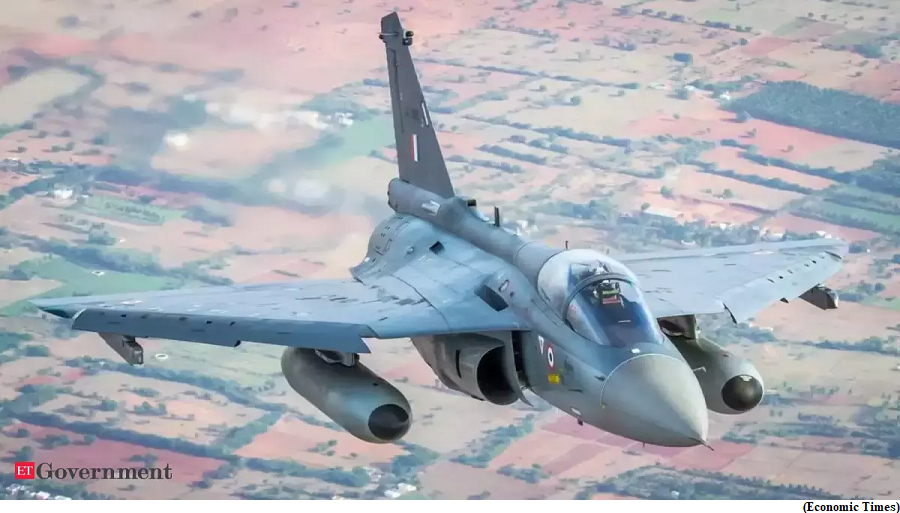Tejas fighter completes seven years of service in Indian Air Force (GS Paper 3, Defence)

Why in news?
- India’s indigenous Light Combat Aircraft (LCA) completed seven years of service in the Indian Air Force (IAF).
- Christened Tejas in 2003 by former prime minister Atal Behari Vajpayee, the fighter aircraft is a multi-role platform that is steadily making a name as one of the world’s premier light fighters.
Key Features:
- Designed by the Defence Research & Development Organisation (DRDO), the multi-role Tejas fighter can perform the roles of air defence, maritime reconnaissance and strike, switching between roles with the press of a button.
- Tejas is built to be an inherently unstable fighter, with a sophisticated and quadruplex flight control system. This allows the pilot carefree handling and enhanced manoeuvrability.
- This multi-role capability is further enhanced by the Tejas’ multi-mode airborne radar, helmet-mounted display system, a self-protection suite and a laser designation pod.
Timeline:
- The first 20 Tejas Mark 1 fighters formed the IAF’s service into Number 45 Squadron, the “Flying Daggers.” Over the years, 45 Squadron has flown Vampires, Gnats and then the MiG-21 BIS, before being equipped with the Tejas Mark 1.
- All the aircraft flown by the Flying Daggers have been manufactured in India, first under licenced production, and then, like the Tejas, designed and developed in India as well.
- In May 2020, No 18 Squadron became the second IAF unit to operate the Tejas – still in its Mark 1 variant.
New LCA Variant:
- The IAF’s confidence in the Tejas is underlined by the latest order for 83 Mark-1A fighters. These will have updated avionics, an active electronically-steered radar, an updated electronic warfare suite and a beyond visual range missile capability.
- The new LCA variant will be capable of firing a range of weapons, missiles and cannon-fire from increased stand-off ranges. The Tejas LCA will see a substantial increase in the overall indigenous content of the aircraft.
- Contracted deliveries of the aircraft are expected to commence in February 2024. In the years to come, the LCA and its future variants will form an important mainstay of the IAF.
- After participating in numerous exercises in the Indian skies with foreign air forces, Tejas made its debut abroad in March 2023 in Exercise Desert Flag in the United Arab Emirates (UAE).
JF-17:
- Meanwhile, China/Pakistan’s JF-17 Thunder was being developed as a cheap and lightweight fighter that could take down the FC-1 Xiaolong. The service has inducted more than 100 Thunder jets since 2007.
IIT Madras launches TREND Setter program to propel decarbonisation research
(GS Paper 3, Science and Technology)
Why in news?
- Recently, the Indian Institute of Technology (IIT) Madras Energy Consortium hosted the ‘Industry Day 2023’ to discuss pathways towards decarbonising Indian Economy.

Trend Setter Program:
- During the event, the Energy Consortium launched a ‘TREND Setter’ program to boost decarbonisation research and extended support to two major and five exploratory research projects.
- These span various topics from green ammonia, carbon capture, battery materials, and sustainable aviation fuels.
- The Consortium aims to deliver significant outcomes in 12 to 18 months through these projects.
Key outcomes of the event included;
- Extending opportunities for Indian Ministry of Micro, Small and Medium Enterprises (MSME)s to decarbonise through Energy.
- Efficiency Services Limited (EESL)’s energy efficiency initiative and the Kotak-IITM Save Energy Mission (KISEM) network of assessment centres.
- Building awareness in carbon trading and the emerging approaches.
India’s commitment:
- India has committed to cutting the emissions intensity by 45 per cent (of 2005 levels) by 2030.
- It has been doing this, partly, via the Perform, Achieve, and Trade (PAT) scheme, where around 1,000 industries have been involved in procuring and trading energy-saving certificates (ESCerts).
India's first domestically built 700 MW nuke reactor starts ops in Gujarat
(GS Paper 3, Science and Technology)
Why in news?
- India's first indigenously developed 700 MW nuclear power reactor at the Kakrapar Atomic Power Project (KAPP) in Gujarat started commercial operations recently.

Details:
- The Nuclear Power Corporation of India Limited (NPCIL) is building two 700 MW pressurised heavy water reactors (PHWRs) at Kakrapar, which is also home to two 220 MW power plants.
- Various commissioning activities were underway at KAPP 4, which had achieved 96.92 per cent progress by May end.
Upcoming projects:
- The NPCIL plans to build sixteen 700 MW PHWRs across the country and has granted financial and administrative sanction for the same.
- Construction of 700 MW nuclear power plants is underway at Rawatbhata in Rajasthan (RAPS 7 and 8) and at Gorakhpur in Haryana (GHAVP 1 and 2).
New sanctions:
- The government has sanctioned building of 10 indigenously developed PHWRs in fleet mode at four locations -- Gorakhpur in Haryana, Chutka in Madhya Pradesh, Mahi Banswara in Rajasthan and Kaiga in Karnataka.




